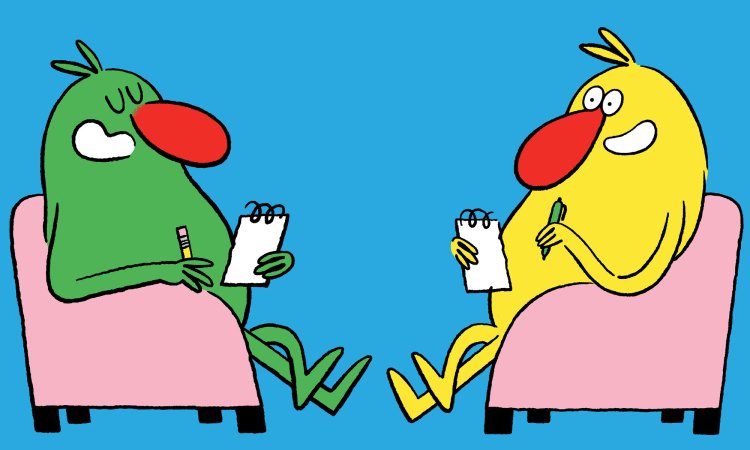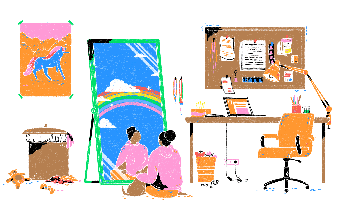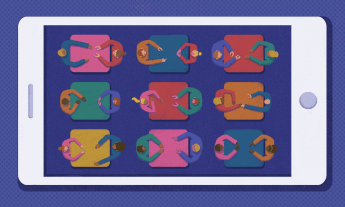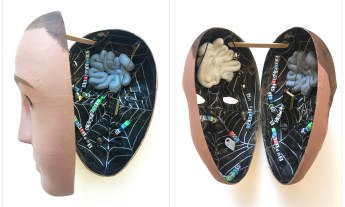
When people are trying out a new therapist, they often tend to put the therapist in the driver’s seat during their initial sessions. But this isn’t quite right — the client should be an equal partner too. What else should people keep in mind during that process? And how can they figure out if a therapist is right for them?
To answer these questions, Brianne Patrice, executive director of Sad Girls Club, a nonprofit dedicated to destigmatizing mental health and wellness in the Black and brown community, spoke with Taylor Blossom, clinical mental health therapist and practitioner at Well WildFlower. The following advice was adapted from that conversation.
1. If you’re a person of color or a member of the LGBTQIA+ community or another specific community, think about how important it is for you to find a therapist who identifies with your lived experience
In most cases, you’re going to foster a relationship easier and quicker with someone who is similar to you. I don’t think it’s impossible to find an excellent therapist who is different from you, but I do think it’s easier to do therapy with someone who’s more like you, especially if it’s your first time easing into that space.
You should also consider your particular issues. For instance, if you’re going to therapy because the world is feeling heavy and you’re trying to process and navigate what it means to be a Black person, then a Black therapist will likely be of most benefit.
Personally, as a woman of color, I will only see a therapist of color because I think all my experiences are shaped by that context in my life. But not everybody thinks like that, so consider your issues and how they affect you.
2. In your first session, ask the therapist about their style
I love it when first-time clients ask about my therapeutic framework, which is basically a therapist’s perspective and how they think problems are best solved. There are several different therapeutic frameworks — some common ones are psychoanalysis, cognitive behavioral therapy and person-centered therapy.
But I know when I first started therapy, I had no idea what a therapeutic framework was. So another way you can find out their approach is by asking them: “How do you do therapy?”
Their answers — whether it’s to the therapeutic framework question or to the “how do you do therapy” question — will tell you how they intend to work with you. For example, I’m a person-centered therapist so in our time together, I’m going to want to talk about all of the aspects of your life. It’s my treatment plan to address all of you, the whole person.
Meanwhile, a cognitive behavioral therapist will ask you about your thoughts and the behaviors that go along with them, while a psychoanalytic therapist would want to explore how you grew up and how you feel like that’s impacting you now.
If you’re going into therapy with a clear intention of what you want to work on in yourself, you’re going to want a style that goes along with that. In this case, it can be worth your doing some research on frameworks beforehand. But if you’re unsure about what you want to explore, you may find that different frameworks or styles could work for you.
Also, ask your therapist about what sort of homework they typically prescribe to clients and what activities they like to do in their sessions. Many therapists do more than just talk — they may incorporate art therapy, movement therapy, sound, healing or meditations.
3. And expect to be asked about your previous experiences with therapy
One of the first questions a therapist will ask when meeting a new client is: “Have you been in therapy before?” If your answer is yes, their next question will usually be: “What worked for you and what didn’t?” And if your answer is no, the next question should be, “What do you think your goal is for this space?”
So before you go into your first session, think about how you’ll respond because how you answer these questions will be incredibly helpful — both for you and for your therapist.
4. If you’ve never been to a therapist before, here’s how to figure out the right type of person for you
One way to evaluate whether they’re a good fit for you is to think about who you normally ask for help in your life — whether it’s a sibling, parent or close friend. What about that relationship and how they relate to you are most helpful to you?
Some people just need to vent, other people want feedback, other people want tools and to know what they can do next, and others want a mixture of both. If you already know what helps you, then you can know what kind of therapist you’re looking for.
Keep in mind that therapy is 100 percent your time. Your therapist should not have their own agenda. They should not have anything but themselves and their internal resourcing to show up and respond to what you’re bringing up.
5. Give yourself six sessions to see whether they’re a good fit for you
In the US, six sessions is typically the minimum amount of time that therapists are given to come up with a diagnosis (something they need to do for these sessions to be covered by health insurance). But even if your therapist is not covered by health insurance, six weeks is still a good amount of time to spend with them.
Why? It’s because we’re ever-evolving as people. At your first session, even though you’re being vulnerable, you’ll likely show up as the best version of you. In other words, the therapist will be in the teacher seat and you’ll be in the student seat, trying to be the best student possible. Even though you may not consciously be playing that role, it’s what most of us have internalized.
Over six sessions, the therapist can observe how you fluctuate. They’ll get more information about how you handle problems outside of therapy and in the real world, which can give them insight into an appropriate treatment plan. And by treatment plan, I don’t mean something as formal as “We’re going to talk about X for X weeks and then do Y.” I just mean how we’re going to deal with whatever is showing up for you.
For a therapist, with some clients it’s easier to see where you’re headed sooner. Some people show up to therapy more ready to do the work than others; they already have their questions and areas to explore. Other people are like, “I’m just here because I feel like I should be, but I don’t know what I’m looking for.” There is no one right way, so I think trying each other out for six weeks should be a standard. That said, if you feel they are absolutely wrong for you, it’s OK to stop seeing them sooner.
6. Your six sessions are over, and the therapist isn’t right for you — be direct
Make your exit similar to how you’d end any other relationship in your life — with respect and with transparency. In your last session, the top three things you should communicate are 1) what didn’t work for you; 2) why you feel now is the time for you to terminate therapy with them; 3) and what you think the therapist could improve on. Since they are someone who’ll be seeing other clients, you want to help them help the next person who will come to them.
Try not to ghost on your therapist. If I were seeing you every week for six weeks, I’m going to worry about your mental health if you’re just gone.
Yes, it will be awkward to give them criticism, but if you can’t model that awkwardness in therapy — which is a safe space for you to do just that — how will you do it in the other parts of your life?
7. When you find the right therapist …
My number-one takeaway is to allow therapy to act as a model space for the rest of your life. It’s your space, so make it yours. It’s the one time and place you get to be as vulnerable and as open as you want, without consequences. So use it to try out some of those things that are uncomfortable for you in the real world.
This post is part of TED’s “How to Be a Better Human” series, each of which contains a piece of helpful advice from people in the TED community; browse through all the posts here.











